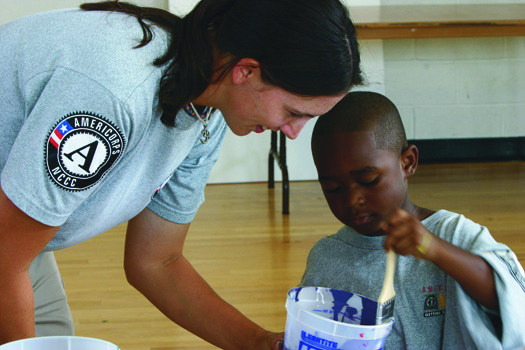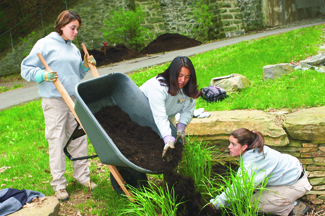 At 20 years old, AmeriCorps is the same age as many of its volunteers. And like any young adult, it is trying to figure out what will make it most successful while carrying a light pocketbook and a big bundle of optimism.
At 20 years old, AmeriCorps is the same age as many of its volunteers. And like any young adult, it is trying to figure out what will make it most successful while carrying a light pocketbook and a big bundle of optimism.
As President Bill Clinton signed the National and Community Service Trust Act in September 1993 and put the word “AmeriCorps” into the national vocabulary, he declared: “I will also use the pen President [John F.] Kennedy used 30 years ago — 32 years ago to sign the Peace Corps legislation, to create a new national service corps for America. We will call it AmeriCorps.”
AmeriCorps became part of the new Corporation for National and Community Service (CNCS), which, in turn, would knit together new and existing federal volunteer programs aimed at tackling problems in education, public safety, poverty, health and the environment.
Shifting VISTAs
Kennedy originally envisioned a domestic counterpart to his international Peace Corps, although Volunteers in Service to America, or VISTA, would have to wait until 1964, when president Lyndon Johnson and Congress created it, and several other anti-poverty programs and started the so-called “War on Poverty.”
In the decades since, “what you see is this sort of ping-ponging as the presidencies change, supporting different kinds of work,” said Melissa Bass, assistant professor at the University of Mississippi’s Department of Public Policy Leadership and author of the 2013 book “The Politics and Civics of National Service: Lessons from the Civilian Conservation Corps, VISTA, and AmeriCorps.”
Indeed, in the late 1960s, VISTA went through a radical phase that saw members organizing direct action, like protests in front of slumlords’ houses. Richard Nixon’s administration shifted VISTAs to more individual service projects, while President Jimmy Carter’s administration pushed back toward community organizing.
Today’s VISTA volunteers are deployed as builders: people who help a community’s organizations grow and do more. That philosophy dates from President George W. Bush, whose administration argued that if federal money is to be spent, it ought to build something lasting.
AmeriCorps 82,000 strong

Catelin Lindsay, 32, is one of those capacity-builders. Now on her second VISTA tour in Atlanta, she works on development, social media and veterans’ outreach at Trinity Community Ministries, a nonprofit that helps formerly homeless men transition into housing and independence. Before that, she worked at a similar homeless services organization, the Gateway Center, and set up a speakers’ bureau.
That first year, about 4,000 people at schools, churches, colleges and community groups heard speakers from her bureau. “I thought it would be so cool to take people across the city to share their story,” said Lindsay. The shelter permanently adopted her program.
Today, CNCS is a $1 billion program. Roughly half of that budget supports the three AmeriCorps programs and their roughly 82,000 volunteers. The biggest, which counts about seven of every eight AmeriCorps volunteers, is the State and National division. It makes grants to organizations, which in turn recruit volunteers to work on a wide range of programs, like disaster services, tutoring or environmental cleanup.
Some 1,200 volunteers work in the National Civilian Community Corps (NCCC), a residential program for people aged 18 to 24, based out of five campuses nationwide. The rest, about 7,700 people, are full-time or summer VISTAs.
By AmeriCorps’ count, their volunteers attracted more than 4 million more volunteers to pitch in on projects in 2012. CNCS CEO Wendy Spencer gave an example to the Senate Committee on Veterans Affairs in April. Team Rubicon, a veteran-led disaster response nonprofit, is an AmeriCorps grantee that managed Hurricane Sandy volunteers in Rockaway, N.Y., “which included approximately 300 Team Rubicon volunteers and 10,000 community volunteers in recovery efforts over a five-week period.”
The people signing up for AmeriCorps are disproportionately female and middle-class, said Peter Frumkin, professor of social policy and faculty director of the Center for High Impact Philanthropy, at the University of Pennsylvania. He coauthored the 2010 book “Serving Country and Community: Who Benefits from National Service?” based on the best available and biggest longitudinal study of AmeriCorps State and National and NCCC volunteers. (See sidebar for impact detail.)
AmeriCorps tightens focus
On the presidential campaign trail in 2008, then-candidate Barack Obama specifically proposed to expand AmeriCorps and channel its energies into five areas: underserved schools, public health, clean energy, veterans in service to veterans and emergency response.
President Obama inherited a VISTA that, at the beginning of 2009, received 400 percent more applications as the year before, and he called service “integral” to achieving “national priorities.”
AmeriCorps today is no bigger than it was in 2008, but it has set up new channels for its volunteers.
Among them are School Turnaround AmeriCorps, which sends teachers to underachieving schools. In cooperation with the Federal Emergency Management Agency, the NCCC now has a 1,600-member FEMA Corps which lends muscle and administrative support to the federal agency’s disaster response programs, such as after Hurricane Sandy. Just announced in April, STEM AmeriCorps members will work to recruit science, technology, engineering and mathematics professionals to volunteer with young people.
And there’s more in the works, said Sandy Scott, senior communications advisor for CNCS.
“We are in discussions with several federal agencies — including the Department of Veterans Affairs — to help them accomplish their mission through national service,” Scott said.
Making a difference
Another agency goal, according to its 2014 federal budget request, is requiring its programs to evaluate progress under a common set of measures.
“Our evaluation work is being used to document evidence of impact for informed decision-making and allocation of resources,” said Scott. (See “Measuring AmeriCorps” for more about VISTA’s impact evaluation.)
The Corporation itself is putting at least two programs under the microscope: Minnesota Reading Corps and YouthBuild, a program for 16 to 24 year-olds that earns them school credit while building housing.
The next big research step, said Frumkin, would be to gather reliable data on AmeriCorps’ impact on communities. “Most of the studies are kind of output studies, where they count the number of shrubs planted in Des Moines or the number of lots that were cleared in Cleveland,” he said. “What happens to non-profits before during and after the introduction of AmeriCorps volunteers?”
Indeed, a 2012 report by the U.S. Government Accountability Office found that CNCS “faces challenges demonstrating outcomes.”
Frumkin co-authored an evaluation from just one state, covering AmeriCorps*Texas volunteers during the 2010-2011 term. He concluded the benefits of the program to the community do outweigh the costs, measured in part by the cost analysis of fully-paid versus AmeriCorps volunteers.
And, as always, the Corporation has its critics. Last year, House Budget Committee Chairman Paul Ryan (R – Wis.) wrote a report in support of a resolution to close CNCS, which said that “participation in these programs [as a volunteer] is not based on need … and paying volunteers is not a core Federal responsibility, especially in times of high deficits and debt.”
U.S. Sen. John Thune (R-South Dakota) co-signed a letter last year accusing AmeriCorps leaders of encouraging volunteers to do what his office called a “double dip” into taxpayer funds by signing up for SNAP — better known as food stamps. At about $9,500 per year as a stipend, with a ban on second jobs, VISTAs earn less than the federal minimum wage.
Scott declined to give AmeriCorps’ attrition rate, saying that “on occasion a member may need to leave the program for a variety of reasons.”
Lindsay said there are ways to get by on low pay, and she suggested that potential VISTAs find a project that really suits their interest and personality. That’s part of what makes up for the pay. And “you get exposure to skills you might not elsewhere,” she said.
It’s not a job, said Lindsay, “it’s an experience.”
Photos, from the top: An Americorps volunteer works with a young student, courtesy Corporation for National and Community Service; Americorps volunteers work together on a planting project, courtesy Corporation for National and Community Service.
Maggie Lee is a freelance reporter based in Atlanta, Ga., who covers state and local government, and quality-of-life issues.































